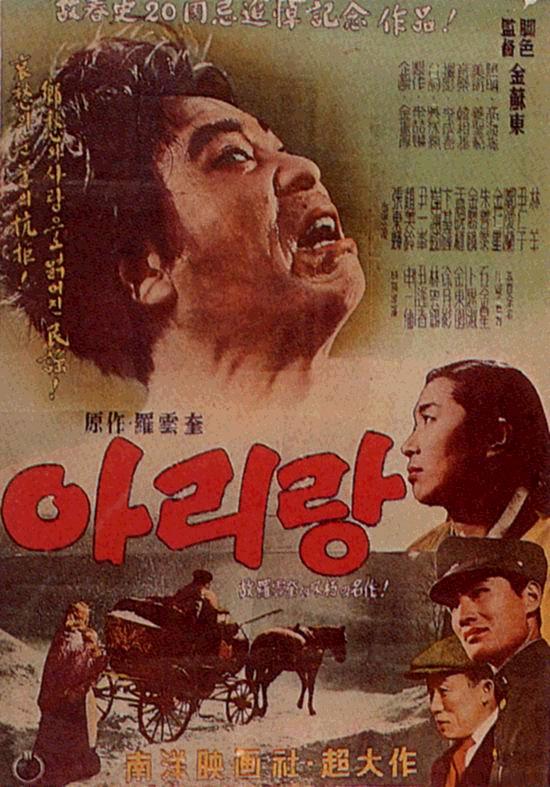- Arirang (1926 film)
Infobox Korean Film
name = Arirang
caption = Theatrical poster to "Arirang" (1926)
director =Na Un'gyu
producer = Yodo Torajo
writer = Na Un'gyu
starring = Na Un'gyu
Shin Hongnyeon
music =
cinematography =
editing =
distributor = Choseon Kinema Productions
released =
runtime = (1,599 feet) (9 reels)
language =Silent film
Korean intertitles
country =Korea
followed_by =Arirang geuhu iyagi
budget = 15,000 Won
imdb_id = 0149706
hangul = 아리랑
hanja =
rr = Arirang
mr = |"Arirang" is a 1926
Korea n film. One of the earliest feature films to be made in the country, it is named after the traditional song "Arirang ", which audiences were said to sing at the conclusion of the film. The silent, black and white film was written and directed byNa Un'gyu (1902-1937), and stars Na Un'gyu,Shin Ilseon andNam Kungun . It depicts life in Japanese-occupied Korea.Plot summary
The film concerns a student, Ch'oe Yeongjin, who has become mentally ill after being imprisoned and tortured by the Japanese for his involvement in the
March 1 ,1919 protest against the Japanese occupation. He returns to live with his father and sister, Yeongheui in their small village home. Yeongjin's friend, Yun Hyeon'gu, is in love with Yeongheui. While the villagers are preoccupied with a harvest festival, O Kiho, a toady for the Japanese police, attempts to rape Yeongheui. Hyeon'gu fights with Kiho, striking and killing him with a sickle. When Yeongjin regains his sanity, he believes himself to have killed Kiho. The film ends with the Japanese police taking Yeongjin over Arirang hill to return to prison.Cast
* Na Un'gyu... Ch'oe Yeongjin
* Shin Hongnyeon... Ch'oe Yeongheui
* Nam Kungun... Yun Hyeon'gu
* Chu In'gyu... O Kiho
* Yi Kyuseol... Yeongjin's fatherImpact
The premiere of the film at Dansung-sa theater in
Seoul onOctober 1 ,1926 [cite book|last=Lee|first=Young-il|coauthors=Richard Lynn Greever (translator)|year=1988|title=The History of Korean Cinema|publisher=Motion Picture Promotion Corporation, Seoul|pages=p.43|id=ISBN 89-88095-12-X] caused a national sensation, and the film was soon shown throughout the country. "Arirang" became an extremely influential film in the history of Korean cinema, and started what is known as the "Golden Age of Silent Films" in Korea which continued until about 1935. It was also the first in a line of nationalist, anti-occupation films which ended with the increased repression of the national culture in the mid-1930s.Na Un'gyu made two sequels to this film: "
Arirang keuhu iyagi " (1930) and "Arirang 3 " (1936). Also,IMDB shows that Na Un'gyu's story for "Arirang" has been remade at least three times since the 1926 debut of the original. Director Lee Kang-cheon filmed his version of "Arirang" in 1954,Yu Hyun-mok filmed his in 1968, and most recently, Lee Doo-yong made a version in 2003.Revered to this day as a masterpiece and milestone in the history of Korean cinema, one of the sites on which the movie was filmed has recently been refashioned into a "Street of Motion Pictures," housing the Arirang Cine Center, Arirang Information Library, a small theme park claiming to be the movie set, a monument in memory of the 100th anniversary of Na Un'gyu's birth, and an annual film festival.
Lost status
Along with almost all other Korean films of this era, Na Un'gyu's "Arirang" is now considered a
lost film . The original nine reels of the film are believed to have been lost during the 1950-1953Korean War . However, a copy of the film was rumored to be in the possession of Japanese collector, Abe Yoshishige, who died in February 2005. His collection of approximately 50,000 films reverted to the Japanese government with his death, but no news has yet come forth as to whether the film was found in the collection. [cite web
title = Collector’s Death May Free Long-Lost Korean Classic Film
url = http://english.chosun.com/w21data/html/news/200502/200502110014.html
accessdate = 2008-06-27]References
Sources
*
*cite book|author= Kim, Kab-ui|year=2001|title=Chunsa Na Un-gyu chonjip : ku saengae wa yesul|publisher=Chimmundang, Seoul|id=
*External links
*
* [http://english.chosun.com/w21data/html/news/200502/200502110014.html Collector’s Death May Free Long-Lost Korean Classic Film] at [http://english.chosun.com/ Digital Chosun Ilbo] February 11, 2005.
* [http://english.yna.co.kr/Engnews/20050222/300900000020050222105347E6.html S. Korea Seeks to Recover Legendary Film 'Arirang' from Japan] by Shim Sun-ah at [http://english.yna.co.kr/ Yonhap News] February 22, 2005. (dead link as ofJune 25 ,2006 )
* [http://rki.kbs.co.kr/english/town/town_street_detail.htm?No=39 Street of Motion Pictures] by Kyung Tae Lee at [http://rki.kbs.co.kr/english/index.htm KBS World] .ee also
*
Korea under Japanese rule
*List of Korean language films
*Cinema of Korea
*Contemporary culture of South Korea
*List of Korea-related topics
*"The Korean folk song Arirang"
Wikimedia Foundation. 2010.
